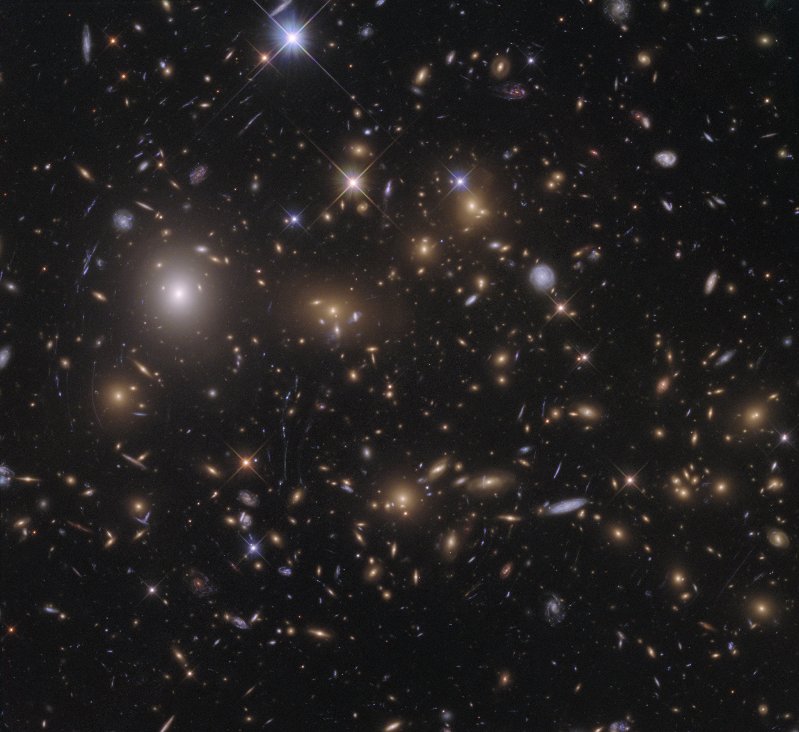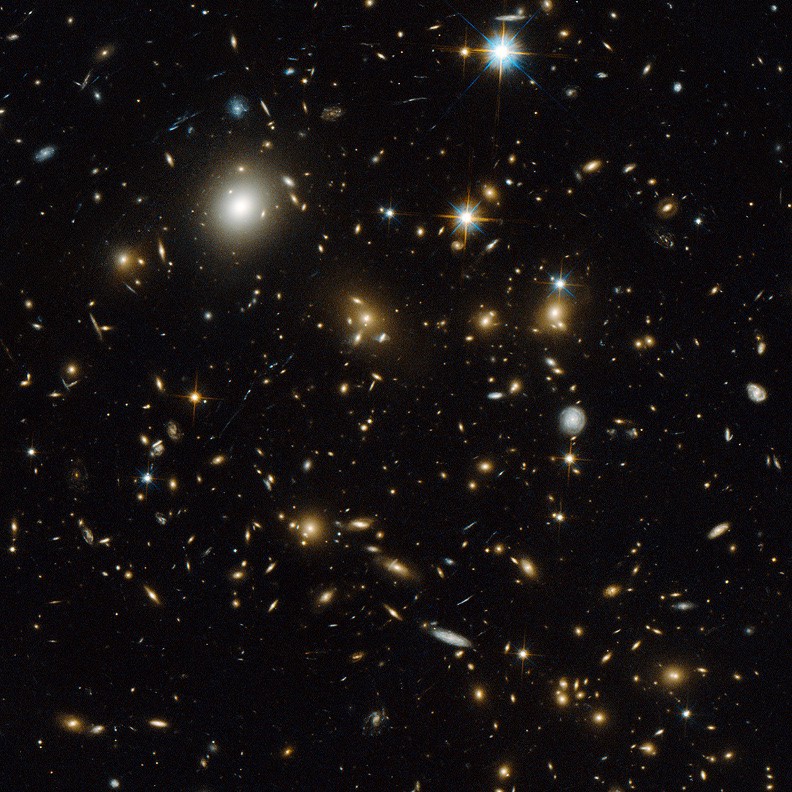 I haven’t got much on my mind today that I want to think about so I distract myself with pictures. This one, as science pictures often do, conflates beauty and truth and let me repeat, beauty. It’s a result of letting the Hubble Space Telescope take repeated pictures of a single cluster of galaxies. Clusters are like families of galaxies, bound together by gravity. I could go on for a long time about clusters but in a way I’m more interested in this picture on account of a personal belief that if you have to choose between truth and beauty, you should choose truth.
I haven’t got much on my mind today that I want to think about so I distract myself with pictures. This one, as science pictures often do, conflates beauty and truth and let me repeat, beauty. It’s a result of letting the Hubble Space Telescope take repeated pictures of a single cluster of galaxies. Clusters are like families of galaxies, bound together by gravity. I could go on for a long time about clusters but in a way I’m more interested in this picture on account of a personal belief that if you have to choose between truth and beauty, you should choose truth.
First, a short bit about the cluster: it’s named MACS J0717. If you could see it in the sky, it would be about a thirtieth the width of the full moon which, since it’s about 5 billion light-years away, is BIG. In fact, it’s one of the biggest clusters anyone’s found. Its little red fuzzy galaxies are called ellipticals, the little blue spiral galaxies are called spirals or if they’re more lens-shaped, they’re a subset called lenticulars. I like trying to see the cluster in three dimensions. The things nearest us are the sparks with spikes coming out, which are stars in our own galaxy, that is, between us and the cluster. The ellipticals and spirals are roughly all at the same distance from us. The farthest are the long blue threads, which are behind the cluster. They’re actually galaxies too, but the cluster is so big that it screws with the images of the galaxies behind; that is, its gravity bends their light, stretching out the images into threads called gravitational lenses.
Back to the picture: it’s certainly beautiful, it’s not quite the truth. It was “taken” by the Hubble in both visible and infrared light, the latter being invisible; so no way, even if your eyes were really large or really sensitive, could you see the picture the Hubble took. In fact, Hubble didn’t so much take the picture as send a data stream to a computer, which after a lot of shenanigans, turns the data into an image. Among the shenanigans is a judgment call about the colors assigned to particular bits of data, especially the bits in wavelengths we can’t see. So all the Hubble images are processed; and one above was processed a little differently by Judy Schmidt, who’s apparently a kind of technical artist and who also started with the Hubble data.
 This is the Hubble’s version and you can see the difference: the Hubble’s shenanigans make the background darker and the galaxies sharper; hers might show the fainter galaxies more clearly. She explains one of her choices: some of those glaxies shining in blue light are so far away that by the time their light reaches us it’s no longer blue. So, she says, “sometimes it is difficult to decide which layer of time to balance the colors at.” That’s not a sentence you hear every day.
This is the Hubble’s version and you can see the difference: the Hubble’s shenanigans make the background darker and the galaxies sharper; hers might show the fainter galaxies more clearly. She explains one of her choices: some of those glaxies shining in blue light are so far away that by the time their light reaches us it’s no longer blue. So, she says, “sometimes it is difficult to decide which layer of time to balance the colors at.” That’s not a sentence you hear every day.
The versions are so different, aren’t they. If I were an astronomer, I’d choose which one I liked better depending on what I wanted to see, detail or faintness. I could be dead wrong here and the Hubble’s is a more accurate representation of what’s really out there. But that wouldn’t change my point: I like Schmidt’s better for no good reason except I think it’s more beautiful. So if you can’t have truth and beauty both at once, and if the truth is too complicated to know, then hell, go ahead and choose beauty.
And of course, what we see is not what’s ‘out there’ – it’s what was five billion years ago. Looking at the sky is the only way we can truly look deeply into the past. I find that beautiful.
HI, TIM! Absolutely right, as per usual.
I don’t see it. The images differ in zoom and rotation, but if you overlay them (not making any colour adjustments), it looks like this: http://i.imgur.com/SUeakkR.gif
All I did was rotate and shrink to line them up – I don’t think either is “truer” than the other.
So you’re more competent with images than I am – which isn’t hard because I’m incompetent. But your overlay is really impressive and striking — do you know this is what astronomers call “blinking the photos?” I’ll bet you knew that. And I don’t see the differences now that I thought I saw. I probably was just responding to the softer colors. So hell, another good essay point shot to hell.
I didn’t think one was “truer” than the other either but I didn’t know what astronomers might think.
I actually didn’t know that – but thanks! I’m sorry to take some of the mystique out of it. I still found the explanation of the varying distances of different features, the way lensing works, and the massive scale of it to be beautiful. What better truth is there?
Astronomers in the olden days “blinked” photo plates to see something that’s not there in one and there in the next — so comets, supernovae, all transient things. And I guess if you’re agreeing with Keats, you can’t be too far wrong.
But you know what, now that I look at your blinked images more closely, I do see tiny faint things in the Schmidt photo that pop out from the Hubble. So I wasn’t as wrong as I thought. One of the best things scientists say about my stories: “Well, it’s not actually wrong.”
In another way, what you see is not really there. In the 5-billion years the cluster’s light took to reach us, due to expansion of the universe it has moved X number of billions of light years further out. It’s called lookback time, I think. I’m not up to calculating MACS Jo717’s real distance from us now. Anybody?
You can discuss the technical merits of these pictures all day and night, and it’s kind of fun sometimes. Still I have a similar photo hanging on my wall and when I pass by it I look at it and think about the universe for a moment. That is the “truth” of these pictures.
Fred, you’re quite right — a different kind of truth.
Considering Hubble’s MACS Jo717 photo contains hundreds of galaxies, each with billions of stars, many of which are orbited by planets, yes, it is a humbling reminder of just how unimaginably big is our universe. But until, if ever, we discover life (sentient or otherwise) beyond Earth, as irreverent as this sounds, we may own the whole shebang.